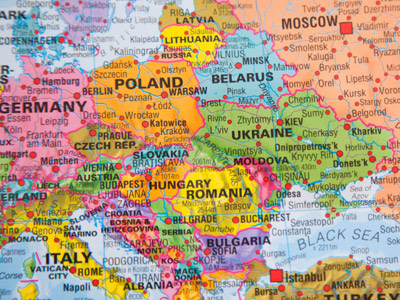
Some elements are named after countries.
Atoms and Elements 04
A fascinating way to revise about atomic numbers. Do you understand symbols and names?
Aged between 11 and 14? This quiz is especially for you.
Scroll down to play the quiz
1 .
Which of the following is a halogen?
Argon
Fluorine
Helium
Neon
The halogens are coloured elements - fluorine (symbol F) is a yellow-green gas
2 .
The elements in group 7 of the periodic table are .......
conductors
gases
metals
non-metals
Group 7 is also referred to in some periodic tables as group 17 and the chemicals of this group are called the halogens
3 .
A pure substance in which all of the atoms are identical is a description of .......
a compound
a mixture
an alloy
an element
Atoms of the same element have the same number of protons in the nucleus as each other
4 .
Li, Na, K and Cs are group 1 elements. The most reactive is .......
Cs
K
Li
Na
The elements in group 1 increase in reactivity as you go down the group. You may have seen a video of this - caesium explodes and destroys the bowl of water
5 .
Lithium floats on water as it .......
is a non-metallic element
is a solid
is less dense than water
is more dense than water
Lithium is a metal in group 1 of the periodic table, its atoms contain three protons
6 .
The name of a gas used in weather balloons is .......
chlorine
hydrogen
neon
nitrogen
Both hydrogen and helium are less dense than air. Helium is used in airships as it is unreactive and so safer than hydrogen (check out the Hindenburg disaster). Hydrogen, however, is still used in weather balloons as it is cheaper than helium
7 .
The following elements are named after famous scientists except .......
curium
einsteinium
nobelium
uranium
Uranium was named after the planet Uranus
8 .
The following elements are named after countries except .......
Fr
Ge
I
Po
Fr Francium - France, Po Polonium - Poland, Ge Germanium - Germany. There are several more!! I is the chemical symbol for iodine, a dark purple solid that is a member of the group of elements called the halogens
9 .
In the periodic table, the elements are arranged in order of increasing .......
alphabetical symbol
electron number
mass number
proton number
Also called the atomic number, it also tells you how many electrons thare are in an atom
10 .
The name of the element with the symbol Na is .......
napthalene
neon
nickel
sodium
This is a common symbol that you will come across dozens of times as you study science
**Unlimited Quizzes Await You! 🚀**
Hey there, quiz champ! 🌟 You've already tackled today's free questions.
Ready for more?
Ready for more?
🔓 Unlock UNLIMITED Quizzes and challenge yourself every day. But that's
not all...
not all...
🔥 As a Subscriber you can join our thrilling "Daily Streak" against other
quizzers. Try to win a coveted spot on our Hall of Fame Page.
quizzers. Try to win a coveted spot on our Hall of Fame Page.
Don't miss out! Join us now and keep the fun rolling. 🎉
**Unlimited Quizzes Await You! 🚀**
Hey there, quiz champ! 🌟 You've already tackled today's free questions. Ready for more?
🔓 Unlock UNLIMITED Quizzes and challenge yourself every day. But that's not all...
🔥 As a Subscriber you can join our thrilling "Daily Streak" against other quizzers. Try to win a coveted spot on our Hall of Fame Page.
Don't miss out! Join us now and keep the fun rolling. 🎉







